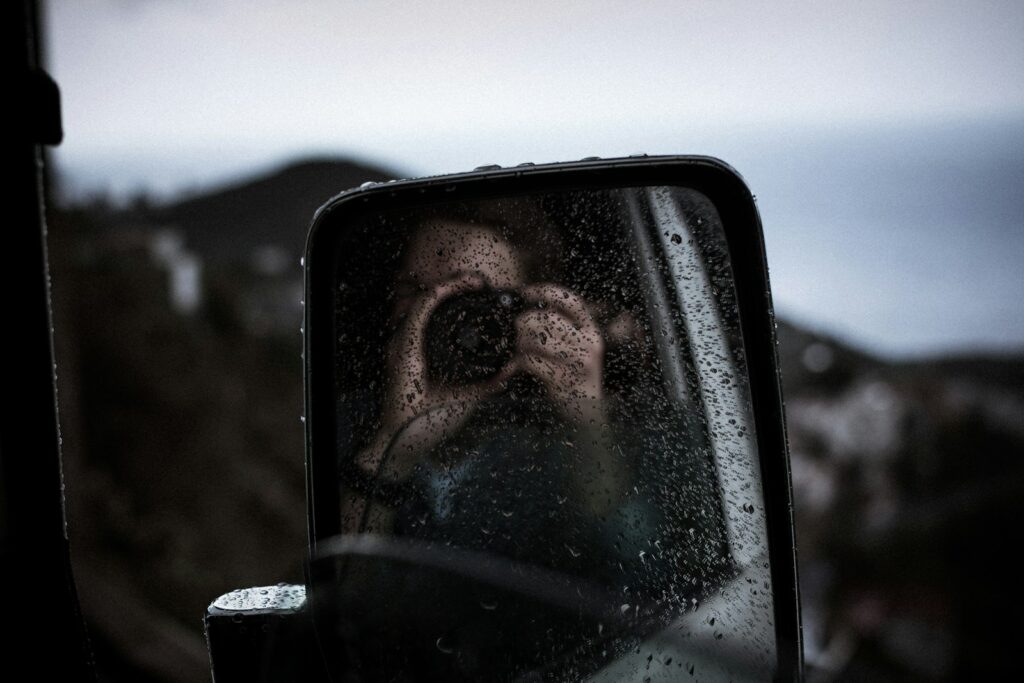Why this episode is worth your time
In this author’s opinion, every episode of Overland Journal Podcast is worth your time. However this one is particularly special for me. Host Scott Brady sits down with Australian photographer and filmmaker Michael Ellem to talk about chasing light, building an enduring creative career, and how vehicle-based travel unlocks images you can’t get any other way. It’s part masterclass, part campfire story: Simpson Desert dawns, Cape York plans, the infamous Telegraph Track, and a 70-Series Land Cruiser built to carry a production team into the rough and back. If you document your trips—or want to—this conversation hits the sweet spot between craft and presence: getting the shot without missing the moment.
The scene: Australia, where light writes the story
Brady opens by calling Ellem “one of the most incredible overland photographers in the world,” then quickly grounds the chat in place: Flinders memories, a bucket-list run to Cape York, and the kind of remoteness that makes Australia an overlander’s dream—or a test. Ellem’s favorite? A specific Simpson Desert dune, reached in the pitch black, two hours before dawn. He seats people where the spectacle will break and watches the color arrive before sunrise—10 impossible minutes, then gone. That’s the heartbeat of his work: planning relentlessly, then surrendering to what the sky gives.
“The sun doesn’t wait for anyone.” — Ellem
It’s why golden hour bookends his days. Everything in between? He and his crew still deliver—using light intelligently, sometimes adding it, always shaping it—because the assignment runs from first glow to last sip of camp coffee.
Loyalty, longevity, and a career built on trust
A big throughline here is loyalty—to your craft and to the people who believe in it. Ellem’s decades-long relationship with ARB grew on consistent excellence and long-term thinking, and it shows up in two ways:
- A look you can recognize: His images helped shape the aesthetic many associate with the brand and modern Australian overlanding.
- A way of working: Show up, be prepared, care about the outcome more than the credit.
Brady mirrors this with his own story: ARB took a bet on Overland Journal before issue one. The subtext for creators is clear: pick partners you can be proud of—and then be the partner they are proud of.
The craft: style, gear, aperture, everything else
Ellem’s advice to new shooters is refreshingly focused:
- Follow your passion through the hard bits. The good times come if you keep going.
- Develop your own style. Borrowing is fine for learning; living there is a dead end.
- Understand aperture. ISO and shutter change exposure; aperture changes the look. Master depth of field and you’ll control the feeling in your images.
Brady adds the practical: you don’t need a vault of glass. A full-frame body and a couple of fast primes (think 35mm/2.8, 50mm/1.8, 85mm/1.8) will do almost everything you need—if you’re willing to move your feet. Michael echoes the thoughts of author/photographer Chase Jarvis:
“The best camera is the one you have with you.” — Ellem (Chase Jarvis)
Yes, even your iPhone. Composition wins. Change height, shift your angle, climb a rock, crouch in the dust—perspective is free.
Presence vs. proof: the balance we all wrestle with
This episode nails a tension every adventure shooter feels: document enough to remember; be present enough to feel. The cure is intention.
- Shoot with purpose. Know the story beats you need: camp life, the climb, the crossing, the faces, the quiet.
- Then step away. Put the camera down. Watch the color with your eyes. Let the place mark you.
The paradox: your best frames often come after you’ve actually experienced the moment.
Vehicles as creative partners (why his 70-Series matters)
Ellem’s rigs aren’t flex pieces; they’re rolling studios. His current 70-Series is built for reliability and repeatability:
- Portal axles for clearance and reduction gearing
- 37s when legal, with pressure tuned constantly to terrain
- BP51 shocks + parabolic leafs out back for articulation and control (he calls the upgrade a “game changer”)
- Organization for true “run-and-gun”—cameras live ready, not buried in Pelicans
He also keeps an ’87 60-Series close to the heart: a rebuilt, naturally aspirated V8 diesel clunker that’s all torque, quirks, and story. Different tools, same purpose: get the team to the scene, then get the scene.
Real talk: when the money runs thin
Ellem doesn’t romanticize the creative life. He tells a story of landing in Cooktown for a big job when a client payment fell through—down to choosing between his own meal or feeding the kids back home. He kept going. Survive the hard seasons, he says, by keeping your expenses low, focusing on long-term decisions, and never losing sight of the work. Brady echoes it: debt-heavy rigs and maxed cards make it harder to say yes to the right opportunities.
Overland wisdom: go prepared
Australia’s remoteness sharpens priorities. Ellem’s short list:
- Spare filters (fuel + air) and the know-how to swap them; at minimum, carry the parts so a passerby can help.
- Tires you trust, a full-size spare, and a repair kit you actually know how to use.
- Research the route (YouTube, forums, maps) and plan before you turn dirt.
The theme repeats: meticulous prep is what buys you the freedom to be creative when the moment comes.
Practical takeaways for your next trip (camera or phone)
1) Build a repeatable shot list (then let the trip exceed it):
- Establishing landscape
- Rig + environment (wide + detail)
- People (portraits and candids)
- Movement (wheels, water, dust)
- Camp life (hands, food, firelight)
- Quiet frames (empty tracks, post-storm stillness)
2) Chase light on purpose:
- Mornings: Be on location 90–120 minutes before sunrise. Scout where the color will break; choose a foreground subject.
- Evenings: Set one meaningful composition and let the sky roll through it. Don’t overshoot; wait for the shift.
3) Compose like you mean it:
- Start with a simple subject + context.
- Change your height before you change your lens.
- Watch your edges—clean frames feel intentional.
- Use aperture to control attention.
4) Pack for presence:
- Keep one easy-reach camera (or phone) always ready.
- Pre-set night exposure for astro/color-pre-dawn experiments.
- Build a “put-it-down window”: 15 minutes every sunrise/sunset with no camera at all.
Why documenting matters (for you and for us)
- For you: Images become memory anchors. A dusty fender, a boil-over kettle in side light—small frames that bring back the smell of the morning and the feel of the wind.
- For your crew: Photos help everyone remember the same story from different angles.
- For the community: Shared images shorten the distance between “maybe someday” and “we’re going.” They teach routes, conditions, etiquette—and respect for places.
Done well, documenting isn’t vanity; it’s service.
Follow: Michael Ellem, Overland Journal Podcast
Want to see more of what Ellem and his team create? He shares regularly on Instagram: @OffroadImages and welcomes questions—photography, shocks, tire pressures, routes, whatever. Much of his commercial work appears through ARB channels as well. (including the ever informative “4×4 Culture” Magazine)
The Overland Journal Podcast is my favorite overlanding-themed podcast and magazine. If you haven’t already – subscribe and enjoy some of the best conversations with the leaders in the lifestyle.
Bottom Line
This episode is a reminder to prepare like a professional and see like a beginner. Know your plan, know your aperture, know where the color will break—and then let wonder wreck your schedule. Take the frame, pocket the camera, and breathe the place in. Your best work—and your best memories—live in that balance.
Here’s to the road unpaved! – Doug

